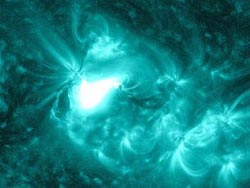New solar active region spitting out flares

The Solar Dynamics Observatory captured this image of an M1.2 class flare on June 13, 2012. The sun is shown here in teal as this is the color typically used to represent light in the 131 Angstrom wavelength, a wavelength particularly good for observing flares. Credit: Credit: NASA/SDO<br>
The region fired off two M-class flares and two coronal mass ejections (CMEs) on June 13 and June 14, 2012. The first flare lasted for a relatively long three hours, peaking on June 13, 2012 at 9:17 AM EDT. The associated CME traveled at approximately 375 miles per second and is directed toward Earth, though due to its slow speed, the effect on Earth is expected to be minimal.
The second M-class flare was also a long-duration flare, and it peaked on June 14, 2012 at 10:08 AM EDT. The CME associated with this flare is traveling much faster – preliminary analysis at Goddard's Space Weather Center indicates it is traveling at speeds of approximately 800 miles per second. It is traveling toward Earth, and could also impact Mars and the Spitzer spacecraft.
The Space Weather Center models estimate that both CMEs will arrive on June 16.
We will provide updates if AR1504 generates additional space weather.
Media Contact
More Information:
http://www.nasa.govAll latest news from the category: Physics and Astronomy
This area deals with the fundamental laws and building blocks of nature and how they interact, the properties and the behavior of matter, and research into space and time and their structures.
innovations-report provides in-depth reports and articles on subjects such as astrophysics, laser technologies, nuclear, quantum, particle and solid-state physics, nanotechnologies, planetary research and findings (Mars, Venus) and developments related to the Hubble Telescope.
Newest articles

A universal framework for spatial biology
SpatialData is a freely accessible tool to unify and integrate data from different omics technologies accounting for spatial information, which can provide holistic insights into health and disease. Biological processes…

How complex biological processes arise
A $20 million grant from the U.S. National Science Foundation (NSF) will support the establishment and operation of the National Synthesis Center for Emergence in the Molecular and Cellular Sciences (NCEMS) at…

Airborne single-photon lidar system achieves high-resolution 3D imaging
Compact, low-power system opens doors for photon-efficient drone and satellite-based environmental monitoring and mapping. Researchers have developed a compact and lightweight single-photon airborne lidar system that can acquire high-resolution 3D…





















